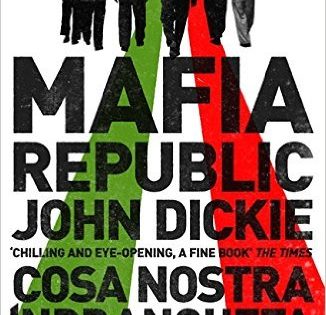
 Mafia Republic: Italy’s Criminal Curse. Cosa Nostra, ‘ndrangheta and Camorra from 1946 to the Present by John Dickie
Mafia Republic: Italy’s Criminal Curse. Cosa Nostra, ‘ndrangheta and Camorra from 1946 to the Present by John Dickie
My rating: 5 of 5 stars
… a wise traveller should bring this book with him on an Italian holiday and read it while tanning on a gorgeous Sicilian beach.
As I was researching for my book Silvio Berlusconi’s Italy: A Portrait of the Country and its Godfather, I stumbled into this thick volume. I had almost involuntarily been dragged into the criminal dark side of Italy since writing about the last twenty years of Italian public life – the Berlusconi Age – meant writing about the permanent mafia-state connections, “a very real deal between the mafia and the state in the founding years of the Italian Republic”, as the author puts it.
So, since it is impossible to write about Berlusconi without writing about the Italian mafias, I dived into ‘Mafia Republic’ and swimming there, so to speak, was a very pleasant activity. First of all, Professor Dickie has a voice of his own, a narrative style that makes this true crime narrative very fluent, catching and interesting. If read extensively, this anxiety-generating story of the Italian ‘organized crime’ gives you a clear general picture; instead, if you are interested in particular aspects and periods, you can also find detailed information on single episodes.
The outsider’s look of the author into Italian matters is an advantage: when a qualified tourist visits a place he often sees things the original inhabitants don’t see anymore, or pretend not to see. Paradoxically, he sees the mafia’s everlasting presence in Italian life much more clearly than most of my fellow citizens and politicians, who have kept denying its presence or diminished its role, repudiating the fact that our three main mafias are crime syndicates, organized, efficient and merciless counter-states. ” … the mafioso was a typical Sicilian, because this [his] exaggerated pride and self-containment had seeped into the island’s psyche as a form of resistance to centuries of foreign invasions. Therefore, to repress the mafia was inevitably to repress the Sicilian people”, writes Dickie quoting a 1930s ‘negationist’ essay.
Since the opening chapter, the author’s position is clear: the mafias are “a monstrous insult to the Italian Republic’s founding values. The mafias’ appalling cruelty is essential to what they are and what they do … through violence, and through the many tactics that it makes possible, the mafias corrupt the Republic’s democratic institutions, drastically curtail the life-chances of its citizens, evade justice, and set up their own self-interested meddling as an alternative to the courts. … nothing short of a criminal regime.” And, soon afterwards, the key and unique characteristic of the Italian mafiosi is pointed out: “Mafiosi are criminal, and they have always been. But ordinary criminals, however organized they may be, do not have remotely the kind of political friendships that senior mafiosi have always enjoyed. It would be far, far beyond the mental horizon of any common-or-garden crook to try and shape the institutional destiny of his homeland in the way Sicilian mafiosi tried to do after 1943.” … “For over 40 years after the establishment of the Republic, … the DC [the ruling Christian Democratic party] provided the mafias with their most reliable political friends … better the mafia than the Communists …”. Better the mafia “than a serious attempt to understand and tackle the island’s criminal system of which many of the governing party’s key supporters were an integral part… the state and the mafia formed a partnership, in the name of the law” (the paradox is taken from the title of first Italian ‘Western’ film on the mafia, a 1949 Pietro Germi movie whose phony message is “mafiosi are not criminal … [they are] an auxiliary police force”.
Alas, in the eighties “Sicily, Calabria and Campania stood at risk of becoming narco-regions, swollen empires of graft, nightmarish mockeries of the civilized Europe to which they purported to belong”. Here the book approaches its climax: this is the period of the Antimafia Palermo Pool, of Falcone’s and Borsellino’s activities and slaughters, of the ‘Maxi-trial’, of the Corleonesi war on the state, of the mafia-state negotiation in the early 90s, of the collapse of the first Republic, of the rise of Berlusconi, of its alleged deal with the devil, of its ascent to political power and of the beginning of the second Republic ‘in the name of the law’, of continuity: when the DC disappeared, wiped away by the ‘Clean Hands’ investigation on endemic political corruption, ‘Forza Italia’ was born, ready to carry on.
Since then, the mafias have adopted a “submersion strategy – ‘walking with padded shoes’, as he [Provenzano] termed it – aimed to keep Cosa Nostra out of the headlines … Under the Second Republic, the battle against the mafias has been carried on largely in spite of the political system, rather than because of it. The strange thing is that some quite extraordinary successes have been recorded all the same”. Indeed, today’s Parliament is still the place with the highest criminal density in the country, corruption runs wilder than in the ‘Tangentopoli’ era and submerged New Deals among politicians and mafiosi are discovered on a daily basis.
In conclusion, this book welcomes you to Italy, land of beauty and corruption, home to both Leonardo and the criminals, where the media are not free and a lot of underground knowledge – or counterculture – is needed. We all know too much about our bright sides, from nature to culture, from food ‘delizie’ to ‘made in Italy’ stylish manufactures. Now it’s time to learn about the other side: that’s why a wise traveller should bring this book with him on an Italian holiday and read it while tanning on a gorgeous Sicilian beach.